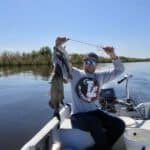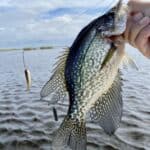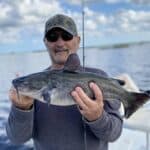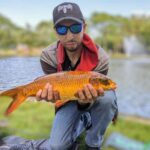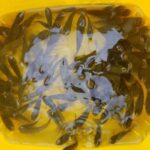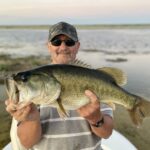Ask any seasoned crappie angler what is the best bait for crappie, and ill bet my last dollar they’ll respond “minnows!”.
It’s true, minnows are the top choice when it comes to crappie bait. But understanding why they work, which types and sizes of minnows work best, and how to hook them is just as important.
In this article, I’ll cover everything you need to know when using minnows for crappie fishing.
By the end of this article, you’ll be ready to hit the water and catch some slabs!
Table of Contents
Why Are Minnows So Good for Crappie Fishing?
Minnows make excellent bait for crappie fishing because they make up a significant portion of a crappie’s diet.
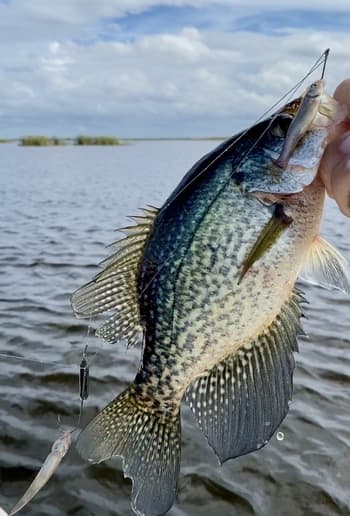
Minnows are also usually very abundant in a wide variety of habitats that crappie call home; everything from small ponds and lakes to large rivers and reservoirs.
Not to mention it’s very easy to catch your own minnows for bait if you follow a few simple tips.
Simply put: Minnows are the main forage source for crappie during all phases of their lifecycle. They love em’!
What Type of Minnows Are Best for Crappie?
While crappie aren’t known for being particularly picky when it comes to minnow types, it is best to stick with minnows that are sourced locally and naturally occurring in their environments. Fathead and bluntnose minnows are great options, as well as golden and emerald shiners.
Fathead minnows are the most common species of bait minnow in the United States, and one of the most common minnows in the entire world. Bluntnose minnow are also extremely common, though less often raised by commercial hatcheries and sold for bait fish.
Both fathead and bluntnose minnows make fantastic live bait options for crappie fishing, as fatheads rarely grow to be more than two and a half inches, and bluntnoses generally max out at three. The maximum recommended size for crappie fishing is ~2 inches.
(If you use minnows larger than 2 inches, crappie will still eat them- but you’ll also have to contend with bass, pike, gar, and other predatory gamefish!)
For these reasons, the minnows sold at bait and tackle shops will rarely be too large for catching crappie, and they will be extremely similar to the minnows that the crappie already eat on a day-to-day basis.
Related: How Many Minnows are in a Pound/Gallon/Scoop?
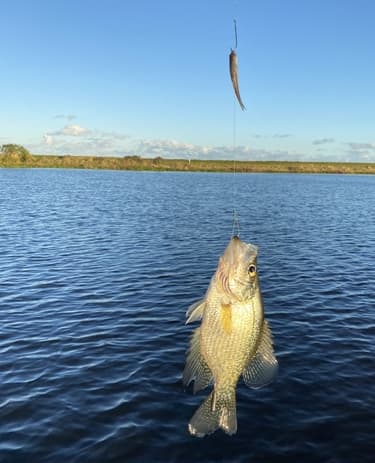
Golden shiners, as well as emerald shiners, can also make great bait options for crappie, though only smaller ones will be suitable.
Shiners can grow to be double the size of fathead and bluntnose minnows, and only smaller ones under two inches are suitable for crappie.
White crappie are also known to feed on smaller and juvenile shad, which can make a great bait option in areas where minnows are either unavailable or just not enticing the fish that day.
What Size Minnows Are Best for Crappie?
The best size minnows to use when targeting crappie are between two and three inches long. They will eat any bait fish small enough to fit in their mouths, and minnows over three inches are usually a bit too large.
If the minnow can fit in the crappie’s mouth, there is a good chance it will try to feed on it. Minnows over three inches are generally too big for average-sized crappie to even attempt to strike, and keeping bait fish under two inches keeps the most possibilities open.
For this reason, it is nearly impossible to go “too small” when it comes to crappie bait. Even tiny minnows have been reported to draw out monster crappie fish!
In fact, downsizing your minnow or crappie lures is an excellent way to get crappie to bite, especially during periods of extreme cold.
What Are the Most Common Minnow Rigs for Crappie?
The most common minnow rig for catching crappie is a simple float rig. Use live minnows on a size number six Aberdeen hook with a split shot weight 8 to 12 inches up the line with a slip bobber adjusted for the depth you are fishing.
The number six Aberdeen hook is the best option for presenting live minnows as bait to crappie.
A snell knot is most often used to tie the hook to the line, as it helps to put pressure in the correct direction to keep leverage on the fish when hooked. Palomar knots are also sometimes used, which many anglers prefer for their ease of tying.
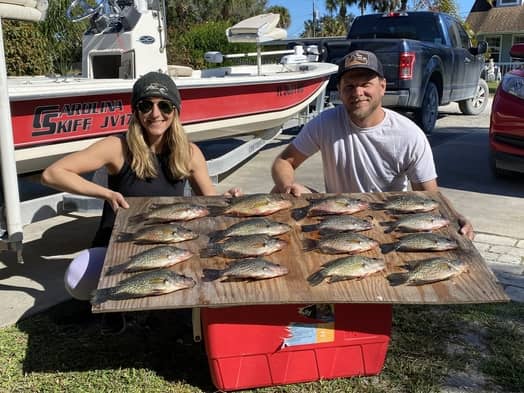
A small split shot weight is crimped onto the line eight to 12 inches up from the hook, keeping the minnow low enough to present to the crappie. A swivel or bead can be added above the split shot for when it comes into contact with the slip bobber.
The split bobber sits above the weight, and a “stop” needs to be added above it to keep the line from sinking all the way down.
A stop is simple to make, just take a couple of inches of extra fishing line, and tie a handful of loop knots until the bobber can no longer slide past it.
Other minnow rigs used when crappie fishing with minnows include the trolling rig, double rig, and drop shot rig.
You May Also Like: Fishing Hook Sizes & Types Explained (With Chart!)
Where To Hook Minnow for Crappie
Minnows are most commonly hooked through the nose, back, tail, or through both cheeks. Each has a different advantage in terms of and swimming action and technique.
Hooking minnows through the nose is one of the most common techniques, and many anglers believe that this method offers the best balance of bait security and swimming action. Hooking through both cheeks provides very similar results.
Minnows that are hooked through the back can provide the most bait security of any technique, though many anglers claim that this method restricts their movement and they will be the least active when presented to crappie.
I often hook dead or frozen minnows in the back since its more secure.
Hooking minnows through the tail allows for the most action and widest range of motion, but it is a bit riskier.
Minnows are more likely to slip off a hook this way, and it is considered by some anglers to be the most high-risk and high-reward approach to hooking minnows.
Will Crappie Bite Dead Minnows?
Crappie will eat dead minnows when offered. If live bait is unavailable, the next best option is to use fresh dead minnows. Crappie are known to bite on fresh dead, and even frozen minnows, though frozen should only be used as a last resort.
Fathead minnows, as well as golden and emerald shiners are extremely common baitfish and can be found at nearly any bait and tackle shop, local hatchery, and in lakes and ponds all over. For these reasons, there is rarely an excuse to not use live minnows if they are available.
While crappie is primarily sight hunters, there are a number of artificial crappie baits available that imitate minnows and other common forage such as grass shrimp and insects.
Night Fishing for Crappie
Crappies are well known as night feeders, and they use the cover of darkness to move into shallower areas in search of food than they would during the day. Night fishing for crappie is a great way to avoid crowds and heat, and crappie are much more predictable in these hours.
Especially during the summer months, crappie can be extremely predictable with their night feeding habits. They will almost always move to slightly more shallow water to congregate and hide in underwater vegetation and other structures.
They lie in wait inside of these hiding places, and opportunistically strike anything passing by small enough to get their mouths on.
Fishing near dock lights or using a submersible crappie light is a great way to increase the chances of landing crappie.
Microscopic plankton are attracted to shining lights during the nighttime and are fed on by larger plankton and insects.
Minnows will come in to feed on the plankton and insects, which attract crappie. Using minnows and a flashlight, it is possible to catch limits on crappie all summer long!
When night fishing for crappie, boating docks and piers are great places to target crappie at night, as they both provide the underwater structure to attract marine life.
See Also: How To Crappie Fish With A Jig- A Comprehensive Guide
If you haven’t guessed yet, I love fishing and everything about it!
To learn more about why I started Panfish Nation, visit the About page and follow along on Social Media:


Download a copy of my FREE Lure Color Selection Chart & Knot Guide!
Stay up to date with fishing reports, tackle reviews, industry news, and much more! We respect your privacy, unsubscribe at any time.

